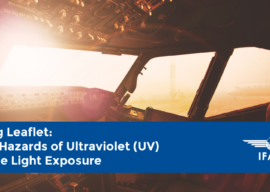
Safety Bulletin IFALPA: Mpox Outbreak Information for Pilots
This bulletin is intended for informational purposes only. In all cases, please follow the guidance of your operator, regulator, and national laws. The World Health Organization (WHO) has just determined that the upsurge of Mpox in the Democratic Republic of Congo (DRC) constitutes a Public Health Emergency of International Concern (PHEIC), following the emergence and rapid spread of a new virus strain. Several outbreaks of Mpox have occurred in different countries, with different modes of transmission and different levels of risk.
IFALPA Briefing Leaflet: Yellow Fever Information for Pilots
IFALPA has updated information for Pilots on Yellow Fever. Please review carefully and, as always, be aware of the regulations and expectations of your operator/employer, and those of your local health authority.
IFALPA Briefing Leaflet: Ocular Hazards of UV and Blue Light Exposure
The range of wavelengths of visible light is from approximately 400 nanometres (nm) to 700nm. The wavelength of UV radiation is below that of visible light, ranging from 100nm to 400 nm. Since UV radiation has more energy than visible light, it may cause damage to the ocular lens of the eye causing cataracts. Blue light may play a role in the pathophysiology of macular degeneration depending on exposure intensity and time (...)
Briefing Leaflet: Ocular Hazards of UV and Blue Light Exposure
6 May 2024 - The range of wavelengths of visible light is from approximately 400 nanometres (nm) to 700nm. The wavelength of UV radiation is below that of visible light, ranging from 100nm to 400 nm. Since UV radiation has more energy than visible light, it may cause damage to the ocular lens of the eye causing cataracts. Blue light may play a role in the pathophysiology of macular degeneration depending on exposure intensity and time (...)
IFALPA Pilot Assistance Manual
This IFALPA Pilot Assistance Manual is intended to provide key information for Pilot Member Associations who wish to establish or enhance existing pilot support programmes. A central aim of the manual is to help operators and regulators understand the development and implementation of these programmes. Such knowledge is important so that they, and all relevant stakeholders, can endorse the establishment of the programmes. This will be fundamental to their success. This Second Edition represents a 2022 update of the original 2018 manual. Much has changed in the field of mental health and wellbeing for pilots since the original version was written, and this edition will refresh the manual with the latest developments and innovations.
Joint statement: Industry Statement for the High-level Conference on COVID-19
We, representatives of international aviation industry organisations, Airports Council International (ACI), the Civil Air Navigation Services Organisation (CANSO), the International Air Transport Association (IATA), the International Business Aviation Council (IBAC), the International Coordinating Council of Aerospace Industries Associations (ICCAIA), the International Federation of Air Line Pilots’ Associations (IFALPA) and the International Federation of Air Traffic Controllers’ Associations (IFATCA), welcome the commitment by Ministers to address the global crisis in aviation caused by the COVID-19 pandemic that has given rise to serious public health, economic and social consequences (...)
Pass sanitaire – Les dernières infos du SNPL / Sanitary Pass – Last SNPL update
Joint Safety Bulletin Occupational Health and Safety in the context of COVID
This joint bulletin (A joint publication with IATA, CANSO, and IFATCA on Safety Risk Assessments (SRA) on the effects of COVID on operations) is a result of the SRA and the webinar series Safely Navigating the Industry Recovery. It highlights key considerations with regards to the impacts of health measures on operational staff, the possible long-term impacts of COVID infections, and best practices for health measures.
Flash Cometec n°3 « COVID-19 et anosmie »
La crise sanitaire liée à la Covid-19 que nous traversons actuellement, outre ses conséquences techniques et économiques, soulève au gré des contaminations nombre de questions et de problématiques jusque-là inédites pour la communauté pilote. La perte du goût et de l’odorat - l’un des symptômes potentiels mais non systématique du virus - dont le terme médical est anosmie (« anosmia » en anglais) en est une parfaite illustration. Sachant que ce symptôme peut persister quelques semaines voire, dans certains cas, quelques mois, et même s’il n’a pas été rapporté pour l’instant d’anosmie définitive, cette privation de certains sens peut avoir un impact notable sur le métier de navigant. Explications.

